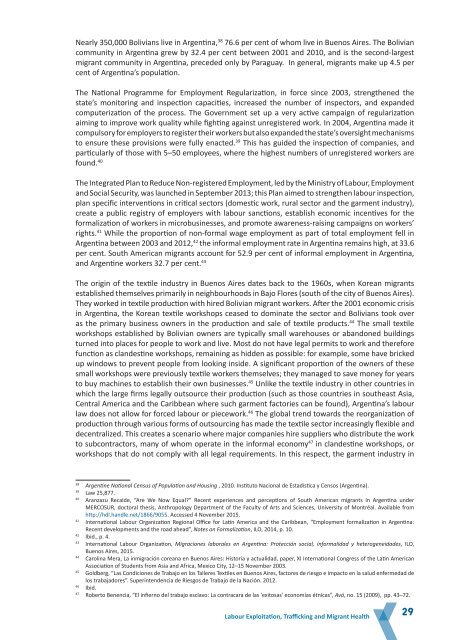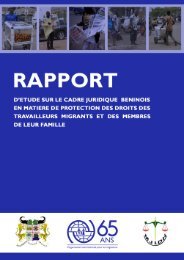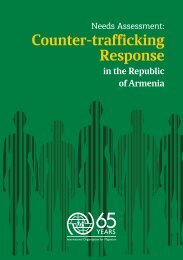Labour Exploitation Trafficking and Migrant Health
labour_exploitation_trafficking_en_0
labour_exploitation_trafficking_en_0
Create successful ePaper yourself
Turn your PDF publications into a flip-book with our unique Google optimized e-Paper software.
Nearly 350,000 Bolivians live in Argentina, 38 76.6 per cent of whom live in Buenos Aires. The Bolivian<br />
community in Argentina grew by 32.4 per cent between 2001 <strong>and</strong> 2010, <strong>and</strong> is the second-largest<br />
migrant community in Argentina, preceded only by Paraguay. In general, migrants make up 4.5 per<br />
cent of Argentina’s population.<br />
The National Programme for Employment Regularization, in force since 2003, strengthened the<br />
state’s monitoring <strong>and</strong> inspection capacities, increased the number of inspectors, <strong>and</strong> exp<strong>and</strong>ed<br />
computerization of the process. The Government set up a very active campaign of regularization<br />
aiming to improve work quality while fighting against unregistered work. In 2004, Argentina made it<br />
compulsory for employers to register their workers but also exp<strong>and</strong>ed the state’s oversight mechanisms<br />
to ensure these provisions were fully enacted. 39 This has guided the inspection of companies, <strong>and</strong><br />
particularly of those with 5–50 employees, where the highest numbers of unregistered workers are<br />
found. 40<br />
The Integrated Plan to Reduce Non-registered Employment, led by the Ministry of <strong>Labour</strong>, Employment<br />
<strong>and</strong> Social Security, was launched in September 2013; this Plan aimed to strengthen labour inspection,<br />
plan specific interventions in critical sectors (domestic work, rural sector <strong>and</strong> the garment industry),<br />
create a public registry of employers with labour sanctions, establish economic incentives for the<br />
formalization of workers in microbusinesses, <strong>and</strong> promote awareness-raising campaigns on workers’<br />
rights. 41 While the proportion of non-formal wage employment as part of total employment fell in<br />
Argentina between 2003 <strong>and</strong> 2012, 42 the informal employment rate in Argentina remains high, at 33.6<br />
per cent. South American migrants account for 52.9 per cent of informal employment in Argentina,<br />
<strong>and</strong> Argentine workers 32.7 per cent. 43<br />
The origin of the textile industry in Buenos Aires dates back to the 1960s, when Korean migrants<br />
established themselves primarily in neighbourhoods in Bajo Flores (south of the city of Buenos Aires).<br />
They worked in textile production with hired Bolivian migrant workers. After the 2001 economic crisis<br />
in Argentina, the Korean textile workshops ceased to dominate the sector <strong>and</strong> Bolivians took over<br />
as the primary business owners in the production <strong>and</strong> sale of textile products. 44 The small textile<br />
workshops established by Bolivian owners are typically small warehouses or ab<strong>and</strong>oned buildings<br />
turned into places for people to work <strong>and</strong> live. Most do not have legal permits to work <strong>and</strong> therefore<br />
function as cl<strong>and</strong>estine workshops, remaining as hidden as possible: for example, some have bricked<br />
up windows to prevent people from looking inside. A significant proportion of the owners of these<br />
small workshops were previously textile workers themselves; they managed to save money for years<br />
to buy machines to establish their own businesses. 45 Unlike the textile industry in other countries in<br />
which the large firms legally outsource their production (such as those countries in southeast Asia,<br />
Central America <strong>and</strong> the Caribbean where such garment factories can be found), Argentina’s labour<br />
law does not allow for forced labour or piecework. 46 The global trend towards the reorganization of<br />
production through various forms of outsourcing has made the textile sector increasingly flexible <strong>and</strong><br />
decentralized. This creates a scenario where major companies hire suppliers who distribute the work<br />
to subcontractors, many of whom operate in the informal economy 47 in cl<strong>and</strong>estine workshops, or<br />
workshops that do not comply with all legal requirements. In this respect, the garment industry in<br />
38<br />
Argentine National Census of Population <strong>and</strong> Housing , 2010. Instituto Nacional de Estadística y Censos (Argentina).<br />
39<br />
Law 25,877.<br />
40<br />
Aranzazu Recalde, “Are We Now Equal?” Recent experiences <strong>and</strong> perceptions of South American migrants in Argentina under<br />
MERCOSUR, doctoral thesis, Anthropology Department of the Faculty of Arts <strong>and</strong> Sciences, University of Montréal. Available from<br />
http://hdl.h<strong>and</strong>le.net/1866/9055. Accessed 4 November 2015.<br />
41<br />
International <strong>Labour</strong> Organization Regional Office for Latin America <strong>and</strong> the Caribbean, “Employment formalization in Argentina:<br />
Recent developments <strong>and</strong> the road ahead”, Notes on Formalization, ILO, 2014, p. 10.<br />
42<br />
Ibid., p. 4.<br />
43<br />
International <strong>Labour</strong> Organization, Migraciones laborales en Argentina: Protección social, informalidad y heterogeneidades, ILO,<br />
Buenos Aires, 2015.<br />
44<br />
Carolina Mera, La inmigración coreana en Buenos Aires: Historia y actualidad, paper, XI International Congress of the Latin American<br />
Association of Students from Asia <strong>and</strong> Africa, Mexico City, 12–15 November 2003.<br />
45<br />
Goldberg, “Las Condiciones de Trabajo en los Talleres Textiles en Buenos Aires, factores de riesgo e impacto en la salud enfermedad de<br />
los trabajadores”. Superintendencia de Riesgos de Trabajo de la Nación. 2012.<br />
46<br />
Ibid.<br />
47<br />
Roberto Benencia, “El infierno del trabajo esclavo: La contracara de las 'exitosas' economías étnicas”, Avá, no. 15 (2009), pp. 43–72.<br />
<strong>Labour</strong> <strong>Exploitation</strong>, <strong>Trafficking</strong> <strong>and</strong> <strong>Migrant</strong> <strong>Health</strong><br />
29





